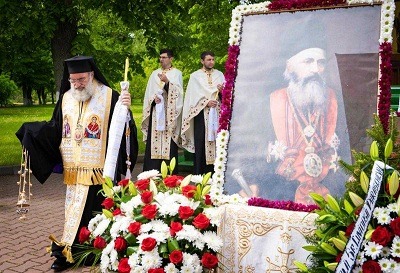
“Father of Romanian autocephaly” Bishop Melchisedec Ștefănescu could be canonized in 2025
Basilica News Agency – Aurelian Iftimiu – 25/6/21
On the 129th anniversary of Bp. Melchisedec’s repose, His Eminence Archbishop Ioachim of Roman and Bacău spoke about the possibility of his canonization in 2025, noting that the file for his canonization is being prepared.
“May God vouchsafe this painting [of Bp. Melchisedec] to become an icon,” Archbishop Ioachim said after officiating a memorial service at the hierarch’s tomb in the city of Roman on Saturday, May 15, 2021.
He also noted that an Akathist and Vespers service have already been composed, and there is already a chapel in Bp. Melchisedec’s honour.
“We hope that all these will be reviewed by the Synodal committees, and we will be glad if a great hierarch of the Romanian Orthodox Church is declared a saint in our generation,” emphasized the Archbishop of Roman and Bacău.
Speaking of the relics of Bp. Melchisedec, Abp. Ioachim noted that “they rest in the Archdiocesan Chapel of St. Antipas of Calapodești, being beautiful, whole, yellow, and fragrant.”
“If God and the saint from Heaven will, he will be canonized in 2025, when we celebrate 140 years of autocephaly,” the archbishop added.
It was Bishop Melchisedec who compiled the reply letter from the Romanian Synod to Ecumenical Patriarch Joachim III in the late-19th century on the issue of the consecration of Chrism in Bucharest [the prerogative of an autocephalous Church], and the letter sent to Ecumenical Patriarch Joachim IV that called for the recognition of Romanian autocephaly.
Bp. Melchisedec was known and respected throughout the Orthodox Church in his time, Archbishop Ioachim noted.
Bishop Melchisedec was born in the village of Gârcina in Neamţ County, on February 15, 1823. He graduated as valedictorian from the Theological Seminary in Socola in 1843. He was tonsured as a monk that same year, receiving the name Melchisedec.
He was ordained as a hierodeacon on August 16, 1844. Two years later, he went to study at the Theological Academy in Kyiv, becoming just the second Romanian to graduate from the school. He was ordained as a hieromonk in Kyiv on October 3, 1851.
Returning to Romania, he held the position of professor and spiritual father at the Seminary in Socola for five years. He was elevated to the rank of archimandrite on January 12, 1856, and appointed rector of the Seminary in Huşi.
In 1857, he was elected deputy in the ad-hoc divan by the clergy from Huşi, where he supported the desire to unite the two Romanian principalities south and east of the Carpathians, becoming one of the leaders of the struggle for union.
The deputies also drafted a program for Church reform, including calling for autocephaly and an end to the election of foreign bishops, stressing the need to end dependence on Constantinople.
He was appointed locum tenens of Diocese of Huşi on January 15, 1861, and was ordained Bishop of Iași on December 30, 1862.
On May 27, 1865, he was officially installed as the ruling hierarch of the newly-established Diocese of the Lower Danube. On February 22, 1879, he was elected bishop of Roman, where he worked with the same zeal, until his departure to the Lord in 1892.
Bp. Melchisedec is also well known for his great wealth of scholarly historical works.
Photography courtesy of the Archdiocese of Roman and Bacău

